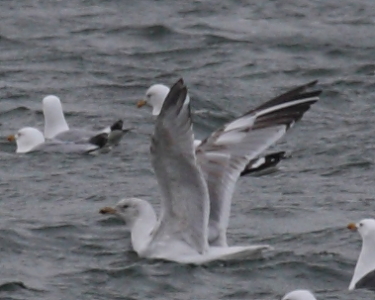Blagdon Lake Birds
March 2012 News
Thursday 1st March [After early fog a beautiful, warm, sunny day developed]
The 4 adult Bewick's Swans Cygnus columbianus bewickii were at Rugmoor again, the 1st-winter ♀ Long-tailed Duck Clangula hyemalis and the ♂ Greater Scaup Aythya marila were both close in to the dam wall for a good part of the day, though the Scaup did venture back to the North Shore as well. During the afternoon I met Ian White who had seen the Common Sandpiper Actitis hypoleucos on the dam earlier in the day.
There were lots of large gulls sitting around on the flat water and there were quite a few small black midges in the air over the dam where I spent a while with the camera mid-afternoon. I was hoping to get some decent pictures of the Long-tailed Duck this afternoon in order to compare the plumage it arrived in with today, but it remained frustratingly just out of range of my telephoto lens. While I was watching it, I saw it preen, wash and then, rather amazingly, it dived and came up porpoising. It exploded clear of the water into another dive and repeated this several times in succession. I've never seen a duck do this before. Here's a picture showing the dark wings and curious yellow staining around the base of the bill.
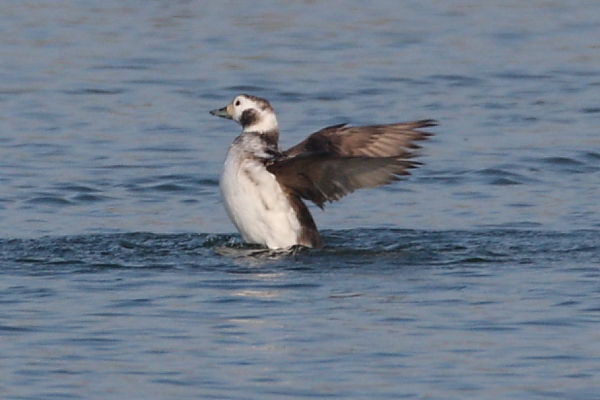
Friday 2nd March [Another foggy start, then it brightened up]
Disappointingly, there were no Common Chiffchaffs Phylloscopus collybita singing, or, Sand Martins Riparia riparia hawking over the lake in the spring sunshine. Neither were the Bewick's Swans Cygnus columbianus bewickii at Rugmoor Point. However, the 1st-winter ♀ Long-tailed Duck Clangula hyemalis and the ♂ Greater Scaup Aythya marila were both present albeit a bit far away to photograph. I saw 3 Northern Lapwings Vanellus vanellus flying around during my walk too. Paul Williams reported the Common Sandpiper Actitis hypoleucos flying along the dam wall.
Primroses Primula vulgaris and Colt's-foot Tussilago farfara both came into flower this week.
I did manage a decent picture of the Lodge Copse Roe Deer Capreolus capreolus buck that's in velvet and received a call from Chris Craig telling me there was a Eurasian Bittern Botaurus stellaris prowling around in front of Stratford hide at Chew Valley Lake which was photogenic in the late afternoon sun. Thanks Chris.
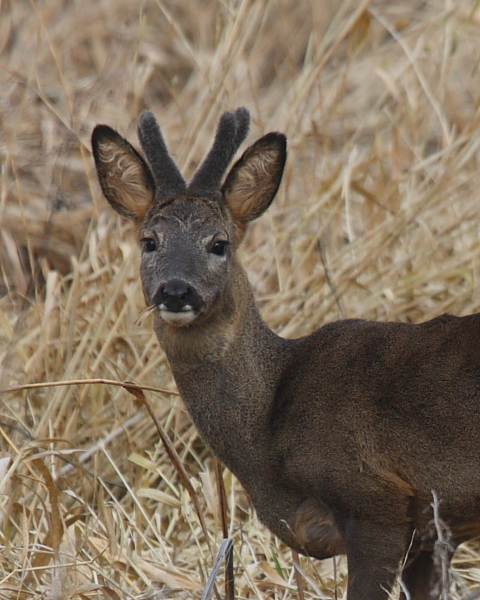
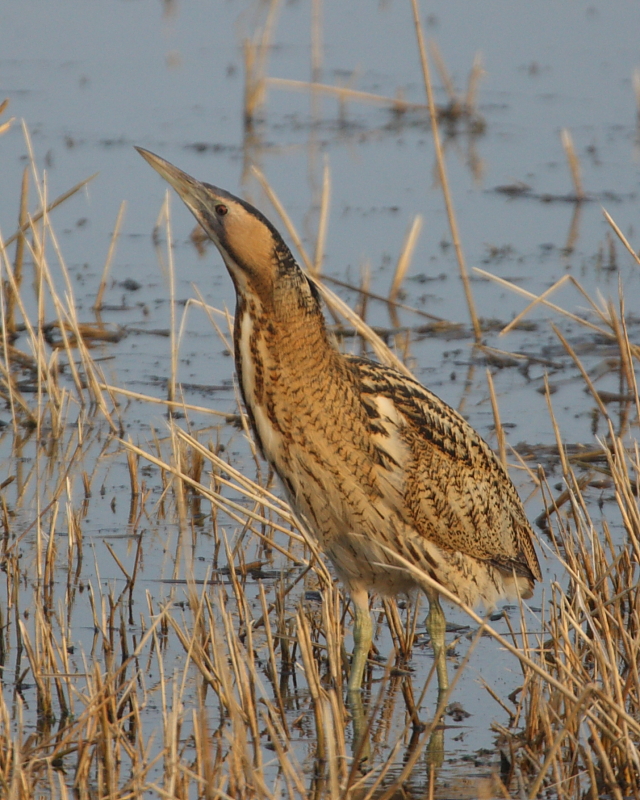
Saturday 3rd March [Sunny intervals and cooler]
The Long-tailed Duck has relocated back over to Chew Valley Lake again, leaving us with just the ♂ Greater Scaup Aythya marila asleep at Cheddar Water and the Common Sandpiper Actitis hypoleucos pottering about on the dam wall of note. I counted 530 Lesser Black-backed Gulls Larus fuscus sitting on the water this afternoon and there was also a pair of Goosanders Mergus merganser in Butcombe Bay.
Sunday 4th March [Rain and sunny intervals with a cold wind]
It was a bit of a miserable morning, so I didn't rush out to look for arriving bird migrants! I met Daniel and Chris of YACWAG, when the rain stopped this afternoon, to put up a bat hibernaculum at the lake that Celia and I have sponsored. As you can see from the accompanying photo, it is quite a lump, made of woodcrete and contains an insulating layer to protect any bats that choose to use it as an alternative to a cave or hollow tree for hibernation. Let's hope it attracts some bats. Daniel is planning to do some systematic trapping around the lake starting in April and we will run some constant effort monitoring equipment to look for patterns in appearance of the various species, particularly Nathusius' Pipistrelles Pipistrellus nathusii.
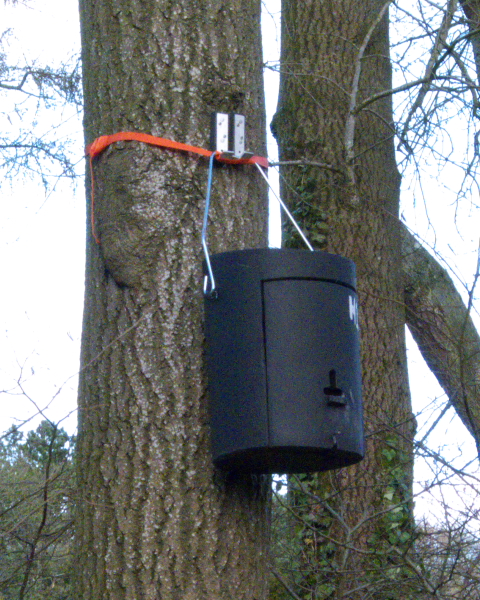 Schwegler 1FW Bat hibernaculum box, Blagdon Lake. 3rd March 2012.
Schwegler 1FW Bat hibernaculum box, Blagdon Lake. 3rd March 2012.
On the bird front, I saw the ♂ Greater Scaup Aythya marila off the dam and that was about it.
Monday 5th March [Sunny, with a cold north-westerly breeze]
I spent a bit of time checking for migrants today, despite the cold wind, but there was no sign of any hirundines at Blagdon, though a friend saw a Sand Martin Riparia riparia at Cheddar. The adult ♂ Greater Scaup Aythya marila was off Butcombe Bank and the Common Sandpiper Actitis hypoleucos was feeding along the dam wall, but that was about it, again. I saw a Small Tortoiseshell Aglais urticae flying around at Wood Bay and have recorded (thanks to Roy Betts for confirming) and photographed the fungus Velvet Shank Flammulina velutipes behind Top End hide on a tree stump by the path.
I ran my 15W Heath Trap overnight (min. temp. 0 Celsius) at Lodge Copse and caught:
- 1663 March Moth Alsophila aescularia 1♂
- 1934 Dotted Border Agriopis marginaria 2♂
- 1960 Early Moth Theria primaria 1♂
- 2182 Small Quaker Orthosia cruda [first site record] 1
- 2190 Hebrew Character Orthosia gothica 2
- 2258 Chestnut Conistra vaccinii 1
Tuesday 6th March [Sunny and warmer]
There was a frost beside the lake last night, but the wall-to-wall sunshine warmed things up quickly. I collected the moth trap which had another new species for the lake in it, but I didn't hear or see any migrant birds. As usual, I did see the adult ♂ Greater Scaup Aythya marila at Cheddar Water and the Common Sandpiper Actitis hypoleucos on the dam wall before heading off for a day's birding in the Forest of Dean, Glos.
The fisheries staff are stocking the lake over the next few days, so you may find the gates open, but please don't drive in and block their path while they drive back and forth moving the fish. Thanks.
According to the Bristol Water website, Blagdon Lake rose 2% to 82% full (93% this time last year) over the last week. Net inflow into all the reservoirs during February was just 44% of the average.
Wednesday 7th March [Showers, cool and windy]
The adult ♂ Greater Scaup Aythya marila was off the dam this morning and the Common Sandpiper Actitis hypoleucos was at Cheddar Water this evening when I went to check the gulls. I 'clicked' 348 Lesser Black-backed Gulls Larus fuscus at 1745 hrs, and saw circa 300 Black-headed Gulls Chroicocephalus ridibundus, 30 Herring Gulls Larus argentatus and a handful of Common Gulls Larus canus while I was counting.
I filled all the bird feeders at lunchtime, the Common Pheasants Phasianus colchicus wait for me to throw them some seed now, and I watched some of the Rainbow Trout Oncorhynchus mykiss being stocked for the start of the fishing season on the 16th of the month. They were beautifully-conditioned fish and the tip-top quality looked to be just what the anglers have come to expect of Blagdon over its 108 year trout fishing history.
Thursday 8th March [Cool with some sunny spells]
More of the same today with the adult ♂ Greater Scaup Aythya marila off the dam and the Common Sandpiper Actitis hypoleucos on the dam wall as it so often is.
Ian White was photographing birds visiting the Lodge feeders and told me he'd seen up to 6 Eurasian Siskins Carduelis spinus coming in to feed on the nyger seed he'd put in one of them. I wonder if they'll stick around to breed if we keep the feeders going through the Spring? A substantial flock of 20-25 European Goldfinches Carduelis carduelis has also been using the feeders. Here's a lovely shot Ian sent me of one of the Siskins that he snapped today. See more on his photostream.
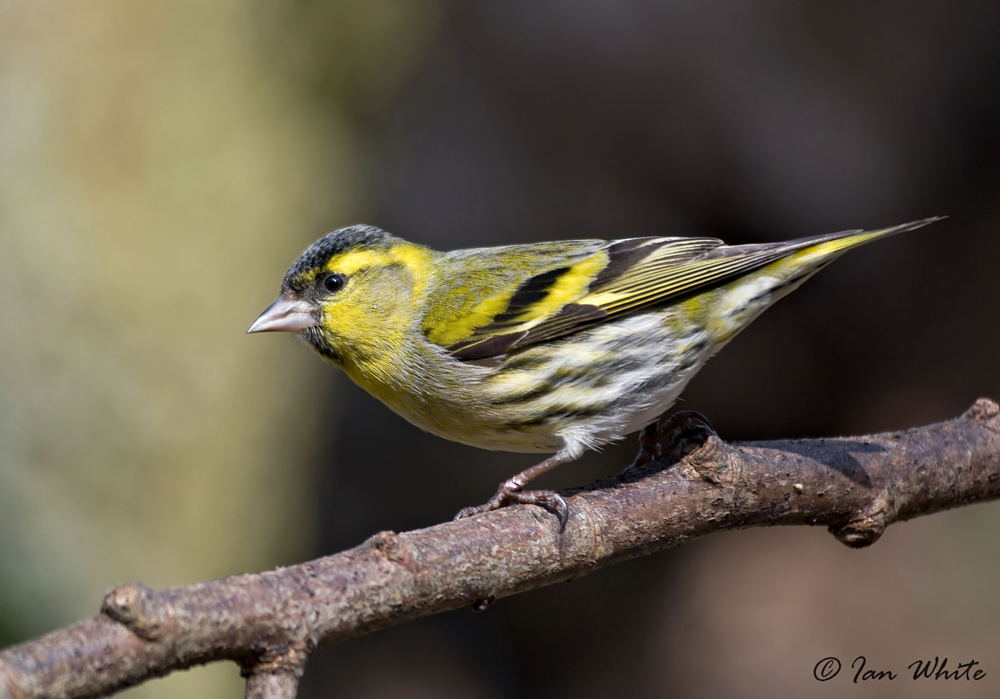 Siskin, Lodge Copse feeders © Ian White, 2012.
Siskin, Lodge Copse feeders © Ian White, 2012.
In the species account I wrote of Mute Swans Cygnus olor "As the food supply dwindles, the swans move away and there are many occasions when none are present during the winter months. It would appear today that Blagdon Lake is of little significance as a wintering site. No doubt artificial feeding has a bearing on the whereabouts of large wintering gatherings e.g. Bristol Docks, though large herds gather on the Avalon Marshes in Somerset to feed on fields beside drainage rhynes. One pair has taken to feeding on Holt Farm Farm fields on the south side of the lake during the winter in recent years rather than leave the lake altogether, perhaps to maintain their breeding territory." This winter, presumably due to a combination of weed availability in the low water in the autumn and mild weather conditions, a good number of Mute Swans have stayed and in the last month or two have been feeding in Holt Farm fields beside Park Lane (up to 10 birds), the east side of the farm (2 birds) and on the north side of the lake by Rugmoor gate (up to 6 birds).
Friday 9th March [Overcast with a cool wind driving down the lake]
I visited this afternoon and saw the adult ♂ Greater Scaup Aythya marila off the Spillway, where I got some pictures, but missed the Common Sandpiper Actitis hypoleucos. It was pretty wild at the Top (east) End and it was hard work going through the wildfowl. I hope the wind dies down a bit for the WeBS Count tomorrow.
When I checked the gulls I didn't see any unusual species, but there was an aberrant 3rd or 4th-winter Herring Gull Larus argentatus that I photographed.
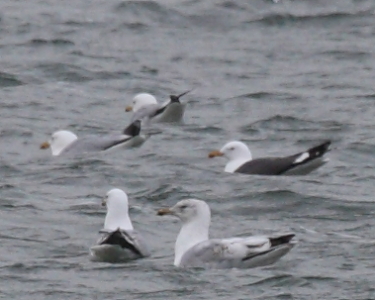
I ran my 15W Heath Trap overnight (min. temp. 9 Celsius) at Holt Copse and caught:
- 0663 Diurnea fagella 1♂
- 1663 March Moth Alsophila aescularia 6♂
- 2182 Small Quaker Orthosia cruda 7
- 2187 Common Quaker Orthosia cerasi 3
- 2188 Clouded Drab Orthosia incerta 1
- 2189 Twin-spotted Quaker Orthosia munda [first site record] 1
- 2190 Hebrew Character Orthosia gothica 5
- 2258 Chestnut Conistra vaccinii 1
Saturday 10th March [Misty early on then sunshine]
We heard 2 Common Chiffchaffs Phylloscopus collybita singing along Butcombe Bank when we started the WeBS Count but there's still no sign of any Sand Martins Riparia riparia. The adult ♂ Greater Scaup Aythya marila was off the dam and the Common Sandpiper Actitis hypoleucos was feeding along the dam wall near the Spillway. The aberrant gull photographed yesterday was still present with a large number of other gulls but there wasn't anything else to set the pulse racing! The count details are on the WeBS Counts page. We counted 1023 individuals of 24 spp.
Lucy Delve saw a Small Tortoiseshell Aglais urticae in flight at Long Bay.
Sunday 11th March [Mist early then warm sunshine]
The wait goes on! Just the adult ♂ Greater Scaup Aythya marila at Cheddar Water and the Common Sandpiper Actitis hypoleucos on the dam wall again today. There were 3 Little Grebes Tachybaptus ruficollis in Pipe Bay and I saw 3 Stock Doves Columba oenas fly out of the Long Bay pines. Even the gull roost was small this evening with a handful of Black-headed Gulls Chroicocephalus ridibundus and circa 50 Lesser Black-backed Gulls Larus fuscus. There were a couple of small bat sp. flying around the trees at the Lodge entrance at dusk.
Hilary Raeburn emailed to say she'd seen 2 Common Kingfishers Alcedo atthis at the Hatchery this afternoon as well as a Peacock Inachis io butterfly sunbathing at Flower Corner. I was pleased to hear that Hilary had seen two Kingfishers because a female had got caught up in one of the hatchery pond protective nets and was rescued by Bristol Waters John Harris on 2nd March.
Nick and Annie Hawkridge reported 2 Great Spotted Woodpeckers Dendrocopos major in the trees by Hellfire Corner, 2 Goldcrests Regulus regulus in the firs at Flower Corner, Rooks Corvus frugilegus in Holt Copse and three flights of 10 to 15 Redwings Turdus iliacus all heading over towards the Chimney by the Hatchery.
I ran my 15W Heath Trap overnight (min. temp. 5 Celsius) at Hellfire Corner and caught:
- 0663 Diurnea fagella 2♂
- 2182 Small Quaker Orthosia cruda 1
- 2188 Clouded Drab Orthosia incerta 1
- 2190 Hebrew Character Orthosia gothica 7
Monday 12th March [Foggy most of the day]
The adult ♂ Greater Scaup Aythya marila remains off the dam wall this morning. There was little else to report other than a probable fly through Eurasian Oystercatcher Haematopus ostralegus heading west and calling in the fog. Oh, and I saw a strikingly small Cormorant Phalacrocorax sp. on the platform in Long Bay with 3 adult breeding-plumaged Great Cormorants Phalacrocorax carbo carbo. It was so noticeably different that I decided to film it with my Panasonic Lumix before getting out of the car to scope it, just in case it was spooked. I briefly entertained the thought of a Double-crested, however, when I scoped it I could see that it was a Great Cormorant, not in breeding plumage (perhaps just one white thigh patch feather), and clearly structurally smaller than the others - daintier, if you like. The gular angle was much the same as the others, so while I suspect it might have been a Continental race P.c. sinensis, it could also have just been a small P.c. carbo. The Common Sandpiper Actitis hypoleucos was on the dam wall again this afternoon.
When I inspected the moth trap this morning, I noticed something had laid lots of eggs on the trays. They are about 1mm in diameter and seem to be consistent with the characteristic doughnut shape of lepidopteran eggs, so I'm guessing one of the species trapped last night was responsible. I'm going to try rearing them on. There's a photo of the eggs in the Recent Images Gallery.
Tuesday 13th March [Foggy]
I didn't visit the lake today and I didn't receive any news from anyone else.
Blagdon Lake is 83% full (92% this time last year) according to the Bristol Water website.
Wednesday 14th March [Cool and misty, then late afternoon sun]
BLAGDON LAKE ALGAE WARNING
14/03/2012 from Bristol Water
Anglers and dog walkers at Blagdon Lake are being warned about the presence of a blue-green algal bloom in the raw, untreated, water. Signs are being posted advising anglers and dog walkers to avoid prolonged contact with water and to prevent their pets drinking or swimming. Dogs should not be inside the reservoir enclosure anyway. This is purely a precautionary measure. The formation of the algae is a natural phenomenon and will not last long. Prolonged contact with water containing high levels of the algae can, in some circumstances, cause skin irritation or stomach upsets.
I wonder if this bloom is a result of all the liquid slurry that has been spread on adjacent fields a couple of weeks ago?
The adult ♂ Greater Scaup Aythya marila was asleep along Butcombe Bank this afternoon and the Common Sandpiper Actitis hypoleucos was on the dam wall at the north end. There was little else to write about, other than the fishing seemed to go well for the Blagdon regulars, with several 'bag limits' being taken.
Thursday 15th March [Cold and foggy]
I got a call from John Harris at Ubley Hatchery this morning, another Common Kingfisher Alcedo atthis had got caught in the pond netting. John managed to free it without harm and we were able to identify it as a male (see 11th March). Hopefully, after this experience, both birds will avoid the ponds. The adult ♂ Greater Scaup Aythya marila was off the dam this afternoon, but I didn't spot the Common Sandpiper Actitis hypoleucos in my brief check. I saw my first Sweet Violets Viola odorata in flower today.
The fishing season starts tomorrow and the boats will be out as well, so this might move some of the wildfowl.
Friday 16th March [Cool and overcast] OPENING DAY OF THE FISHING SEASON
At long last, I saw 6 Sand Martins Riparia riparia fly west at Cheddar Water while I was leaning on the dam wall chatting to Mervyn Pearce. They appeared to fly along the back of the dam, but we didn't see them again. I also heard 3 Common Chiffchaffs Phylloscopus collybita singing (at Lodge Copse, Hellfire Corner and Ash Tree). The adult ♂ Greater Scaup Aythya marila was between the dam and Fishing Lodge and the Common Sandpiper Actitis hypoleucos was on the dam wall this afternoon. I saw a few Cuckooflowers Cardamine pratensis open in ditches at Flower Corner and Top End, as well as a single Cowslip Primula veris in full bloom on the North Shore.
On the down side, because most of the boats gathered along the North Shore the Common Goldeneyes Bucephala clangula seem to have flown off (to Chew?) and the handful of Eurasian Wigeon Anas penelope though very flighty, were still present when I came home.
The fishing seemed to go well for most anglers that I chatted with, especially those along the North Shore, but you will no doubt find out more on Mark Chamberlains Blagdon Lake website later this evening. One guy got a surprise when he foul-hooked a Pike Esox lucius of just over 25lbs in the tail!
Saturday 17th March [Warmer but still overcast]
The Common Sandpiper Actitis hypoleucos was on the dam and I eventually spotted the adult ♂ Greater Scaup Aythya marila over against Butcombe Bank, but there were no Sand Martins Riparia riparia hawking over the lake. There were also a large number of gulls at lunchtime, mainly Lesser Black-backed Gulls Larus fuscus and Black-headed Gulls Chroicocephalus ridibundus, however, there was no sign of the Iceland Gull Larus glaucoides that popped into Cheddar Reservoir roost last night.
Sunday 18th March [Mainly sunny and warm]
I had an away day today and didn't get back until dusk when I went down for a look over the dam. I spotted the adult ♂ Greater Scaup Aythya marila off the dam, but couldn't see the Common Sandpiper Actitis hypoleucos in the gloom.
Monday 19th March [Warm. Blue sky and fluffy white clouds with a stiff breeze over the water.]
The Common Sandpiper Actitis hypoleucos was on the dam and the adult ♂ Greater Scaup Aythya marila off Butcombe Bank, until it was moved by fishing boats. Other selected counts included 6 singing Common Chiffchaffs Phylloscopus collybita, 10 Common Goldeneyes Bucephala clangula (decreasing), 15 Eurasian Wigeon Anas penelope (about the same), 15 Great Crested Grebes Podiceps cristatus (increasing), 12 Canada Geese Branta canadensis (fluctuating daily), 123 Lesser Black-backed Gulls Larus fuscus and 6 Herring Gulls Larus argentatus (both probably decreasing).
Surprises included a singing ♂ Cettis Warbler Cettia cetti on the North Shore and Blackcap Sylvia atricapilla in the garden of the Inspection House. Plants noted flowering included Wood Anemone Anemone nemorosa, False Oxlip Primula x polyantha and Bluebell Hyacynthoides non-scripta.
Tuesday 20th March [Cool and cloudy with sunny spells] VERNAL EQUINOX
The adult ♂ Greater Scaup Aythya marila was off the dam and the Common Sandpiper Actitis hypoleucos was at Cheddar Water. There were 22 Canada Geese Branta canadensis on Holt Farm fields and 3 Great Black-backed Gulls Larus marinus (2 adults and a 1st-winter) among the few Lesser Black-backed Gulls Larus fuscus late afternoon.
I ran my 15W Heath Trap overnight (min. temp. 7 Celsius) at Hellfire Corner and caught:
- 1746 Shoulder Stripe Anticlea badiata [first site record] 2
- 1960 March Moth Alsophila aescularia 2♂
- 2182 Small Quaker Orthosia cruda 2
- 2187 Common Quaker Orthosia cerasi 1
- 2188 Clouded Drab Orthosia incerta 5
- 2190 Hebrew Character Orthosia gothica 8
Wednesday 21st March [Overcast and mild with a light easterly breeze]
BLAGDON LAKE ALGAE WARNING
21/03/2012 from Bristol Water
Routine sampling has shown that the levels of blue-green algae in the raw, untreated water at Blagdon Lake have returned to normal and the advisory signs will now be removed. Signs had been posted advising anglers and dogwalkers to avoid prolonged contact with water and to prevent their pets drinking or swimming.
The adult ♂ Greater Scaup Aythya marila was off Butcombe Bank and the Common Sandpiper Actitis hypoleucos was on the dam wall early this morning. There were no hirundines flying about, despite the large number of black midges over the water and surrounding vegetation, however, there does appear to have been an arrival of Blackcaps Sylvia atricapilla. I heard several singing this morning in the various spots that I visited. I've just totted up 99 bird species recorded at the lake so far this year. A single drake Gadwall Anas strepera has been present for the last 3 days but I've seen no sign of a mate.
I noticed Marsh Marigold Caltha palustris in flower today while collecting the moth trap. Shoulder Stripe Anticlea badiata was added to the growing lake list last night, as we inch closer to 300 spp. It's a smart moth and I've added a picture to the Macro-moths gallery.
Thursday 22nd March [Sunny and warm with a steady easterly breeze again]
IT'S ANOTHER RED LETTER DAY: 2 COMMON CRANES FLY OVER
No, not the arrival of any more Sand Martins Riparia riparia, or even the first Barn Swallow Hirundo rustica, but 2 Common Cranes Grus grus flew north, or north north-east, over at 1330 hrs. This is likely to be the first acceptable record, though I recall seeing a Rare Bird Alert message when I was in Birmingham one day, probably in the late 1990s, saying one had flown south over the lake. However, I don't think the record was submitted, though I can't say for sure because Avon Ornithological Group don't publish details of rejected records. Nevertheless, a bird was located shortly afterwards in Devon, so you have to suspect this was probably a good record that got away (I've tried looking for the record on the Rare Bird Alert database without success). Richard Archer, RSPB Somerset & Severn Estuary Conservation Officer, emailed me shortly after I'd put the news out to say that "We've lost two of our Somerset cranes... We're looking for colour ringed birds. They should both have black-blue-black rings on their left legs and unique colour codes on the right. They were led off by a wild crane last weekend and we haven't heard anything about them!" Whilst I didn't think to look for rings, it seems likely that these were the two missing introduced cranes minus the wild one. So, keep an eye out for them.
I saw the Common Sandpiper Actitis hypoleucos on the dam wall but didn't locate the Greater Scaup Aythya marila. The midges were so thick over the dam this afternoon, there were times when I couldn't see the cars parked at the other end! It made for uncomfortable viewing, so I gave up!
I also noted 3 Peacocks Inachis io and 3 Small Tortoiseshells Aglais urticae in the sunshine today.
I am planning to have a look at the Chironomidae (non-biting) midges this year because they have always fascinated me, but from an entomological point of view I don't know that much about them. They are a driving force in the ecology of the lake forming a major part of the food supply for many predators such as other insects, fish, bats and, of course, birds. So I went to the lake armed with a macro lens, extension tubes and twin-lite flash today. There are three images taken hand-held in the Recent Images Gallery. I think I will use a tripod in future, but it's a learning exercise. There is a picture of the small species (about 4mm) of black Chironomid flying today. The pair in cop are a female on the left and male with 'feathery' antennae on the right, but there is another male trying to muscle in behind the female. The female is actually quite plump with an orange abdomen ventrally and the male is a grey-olive colour. They are mating on the side of the Lodge which doesn't make for a great shot I know. The other images are of the large black midge, male and female. They are actually quite grey rather than black when seen this close-up and have golden hairs on the abdominal segments. I am waiting for a key to Male Chironomidae to arrive in the post and hope to identify them later.
Friday 23rd March [Bright, sunny and warm]
I didn't visit today, preferring to go to the Spring Steam Gala on the West Somerset Railway to photograph steam engines which are another passion of mine. I haven't received any news from anyone who may have visited the lake either, but there has been an interesting development on the Common Crane Grus grus front so thanks to Damon Bridge for the following information:
"All 34 cranes are here this morning... so our three wandering birds have returned. We had 31 all week and at lunch time yesterday too but 34 today - so we assume that the 3 returned together. This makes me think that it is more likely that the two you saw above Blagdon were possibly nothing to do with the released birds, and were spring migrants or winter wanderers from another source. I think we will probably never know.
Incidentally the 2010 birds are fitted with leg-mounted radio tags - but unfortunately most of the older birds have now been so enthusiastic with their preening of them that the aerials, which are tough wire that you or I would need wire cutters to get through, have snapped off. They have been rendered useless - unless you are right on top of them with the receiver.
In 2011 about half of the birds have radio tags mounted on a back-pack harness. These seem to be lasting much better - so we will have a better chance of finding them when the go wandering next Spring. The other half have the tags mounted on black rings (rather than red rings as used in 2010). We have noticed that they have been much less interested in the tags and the aerials are holding up well. It could be that the urge to 'preen' them is colour related - or that the red colour is causing some kind of instinctive pecking.
All the best for now, Damon."
If you'd like to read more about the Somerset cranes visit thegreatcraneproject website.
Saturday 24th March [Blue sky and very warm]
The adult ♂ Greater Scaup Aythya marila seems to have returned to Chew Valley Lake, leaving just the Common Sandpiper Actitis hypoleucos of any note. It was on the dam early this afternoon. There are no hirundines hawking insects over the lake still, but the influx of Common Chiffchaffs Phylloscopus colybita and Blackcaps Sylvia atricapilla continues apace. I counted 11 ♂ Chiffchaffs and 6 ♂ Blackcaps singing along the south side of the lake at lunch time. I also counted 150 Lesser Black-backed Gulls Larus fuscus (all adults), 18 Herring Gulls Larus argentatus (mixed ages) and 17 Common Black-headed Gulls Chroicocephalus ridibundus (mixed ages). 2 Northern Ravens Corvus corax were over the Lodge again today and a smart ♂ Eurasian Siskin Carduelis spinus was feeding in the top of the Poplar trees by the bridge at Long Bay.
There were a few butterflies on the wing again and I noted 2 Commas Polygonia c-album, for the first time this year, at Top End. I also saw quite a few Large (or Dark-edged) Bee-flies Bombylius major feeding at Lesser Celandine Ranunculus ficaria flowers along the roadside behind Top End hide (a good spot to see them every year). The Pussy Willows Salix sp. are also in flower and attracting quite a few insects, including Bumblebees, to this early food source. I was carrying my 100-400 mm telephoto lens over my shoulder today but took a couple of record shots from about 2 metres away - I always seem to be carrying the wrong lens when I go walking at the moment! The 180 mm macro would have been the ideal tool this afternoon.
I have posted a shot of the Bee-fly in the Recent Images Gallery showing the long proboscis that can be seen in flight, when the insect hovers in the sunshine. It is a parasite of some solitary bees. There is also a picture of a Buff-tailed Bumblebee Bombus terrestris, probably a queen, feeding on the Willow. I also saw a bright ginger bumblebee, almost certainly Bombus pascuorum, although it's difficult to be sure as there are two similar species which could also both occur, although they are generally later on the wing.
I ran my 15W Heath Trap overnight (min. temp. 5 Celsius) at Holt Copse and caught:
- 1746 Shoulder Stripe Anticlea badiata 1
- 1960 March Moth Alsophila aescularia 2♂
- 2187 Common Quaker Orthosia cerasi 2
- 2188 Clouded Drab Orthosia incerta 2
- 2190 Hebrew Character Orthosia gothica 3
- 2256 Satellite Eupsilia transversa 1
- 2260 Dotted Chestnut Conistra rubiginea [first site record] 1
Sunday 25th March [Sunny and warm again]
I picked the moth trap up early this morning and had a quick look over the lake. There was another new moth for the lake, in the shape of a Dotted Chestnut Conistra rubiginea, which keeps the list ticking over.
I didn't spot anything new on the bird front, before I went out for the day. However, I did see 3 Stock Doves Columba oenas collecting grit from the road in Lodge Copse and 2 Little Grebes Tachybaptus ruficollis in Home Bay. Both these species have been seen infrequently during the last few months.
Monday 26th March [Ne'er a cloud in the sky and the warmest day of the year so far]
Visible migration still appears to be slow and just when I was expecting an Osprey Pandion haliaetus, one appeared, flying a couple of hundred feet up away from me at Top End while I was chatting with Mike Churn (nice to meet you, at last, Mike). I called "it's an Osprey" and fired off a couple of distant shots with my camera and Mike went to get his bins out of the car and got on the bird while I set my scope up. I looked up with my bins and got the scope on a Red Kite Milvus milvus as it circled over the transmitter on Breach Hill. Somewhat puzzled, I rang Richard Mielcarek who was at Chew, who also managed to get on it, before it flew off towards Chew Stoke. This is the third lake record (fourth bird). Later, I checked my photos and sure enough I had photographed an Osprey but bizarrely set my scope up on a Red Kite! Andy Davis had the Osprey at Chew minutes later, simultaneously, and independently, while Rich was watching the Kite! This really was a case of 'the two bird theory'....
I heard my first Willow Warbler Phylloscopus trochilus of the year, singing on Rugmoor Point, and counted 27♂ Common Chiffchaffs Phylloscopus colybita and 10♂ Blackcaps Sylvia atricapilla also singing around the lake. A flock of approx 60 Common Black-headed Gulls Chroicocephalus ridibundus flew east, followed by 6 a little later on, but that was basically it. I inadvertently flushed a Common Snipe Gallinago gallinago from a Top End ditch and 2 (presumed) Lesser Redpolls Carduelis cabaret flew over calling while I was at the Lodge. The Common Sandpiper Actitis hypoleucos was on the dam still.
I ran my 15W Heath Trap overnight (min. temp. 6 Celsius) at Home Bay Point and caught:
- 2182 Small Quaker Orthosia cruda 4
- 2188 Clouded Drab Orthosia incerta 1
- 2190 Hebrew Character Orthosia gothica 7
Tuesday 27th March [More of the same]
The Common Sandpiper Actitis hypoleucos remains on the dam, but there was none of yesterdays excitement on the bird front, even though I kept peering skyward in hope, and we still have no hirundines. What's going on?
I decided to check some of the ditches at Flower Corner and Top End, with their banks so delightfully lined with flowers, and had a lovely surprise when I found a Dotted Bee-fly Bombylius discolor. There were lots of Large (aka Dark-edged) Bee-flies B. major on the wing too. The Dotted Bee-fly that I photographed looked a darker ginger on the abdomen with a blackish tail compared with the Large Bee-flies which all appeared to be a pale ginger all over. I don't know if this is a consistent feature, but will try and get some 'proper' macro shots for comparison tomorrow or Thursday. I also saw a Grass Snake Natrix natrix cross the road at Hellfire Corner. I've put a couple of pictures on the Recent Images Gallery, though I will qualify them by saying I used the 100-400mm telephoto lens with 1.4x extender, rather than a macro lens!
I ran my 15W Heath Trap overnight (min. temp. 4 Celsius) at Lodge Copse and caught:
- 1960 March Moth Alsophila aescularia 1♂
- 2182 Small Quaker Orthosia cruda 3
- 2188 Clouded Drab Orthosia incerta 3
- 2189 Twin-spotted Quaker Orthosia munda 1
- 2190 Hebrew Character Orthosia gothica 5
- 2258 Chestnut Conistra vaccinii 1
Wednesday 28th March [Hot]
I saw very little at the lake today, in two brief visits, save for the Common Sandpiper Actitis hypoleucos on the dam. I hope to spend more time with a macro lens photographing some of the early invertebrates tomorrow, but keeping an eye on the skies as well, just in case!
I ran my 15W Heath Trap overnight (min. temp. 6 Celsius) at the Spillway and caught:
- 1750 Water Carpet Lampropteryx suffumata [first site record] 1
- 2182 Small Quaker Orthosia cruda 5
- 2185 Lead-coloured Drab Orthosia populeti [first site record] 2
- 2188 Clouded Drab Orthosia incerta 4
- 2189 Twin-spotted Quaker Orthosia munda 2
- 2190 Hebrew Character Orthosia gothica 5
- 2256 Satellite Eupsilia transversa 1
- 2258 Chestnut Conistra vaccinii 1
I have recorded Lead-coloured Drab Orthosia populeti because I caught them near a stand of what I think are Grey Poplars Populus x canescens. However, there were no local records in the 'Moths of the Bristol Region', so I had to be wary of suggesting this until I'd gathered some other opinions and/or had a gen. det. carried out. Richard Andrews thinks they are probably this species and told me that John Martin had caught one recently.
Thursday 29th March [Blue sky and warm]
There's not too much happening with the birds still. I saw a Little Egret Egretta garzetta at Top End, the Common Sandpiper Actitis hypoleucos on the dam and there were a few Eurasian Siskins Carduelis spinus in Lodge Copse this afternoon.
The breeze seemed to reduce the number of insects on the wing this afternoon, but I still enjoyed a few hours trying to capture some photos of Bee-flies. I saw my first Speckled Wood Pararge aegeria and Brimstone Gonepteryx rhamni at the lake this year and a male Orange-tip Anthocharis cardamines along the road by Henmarsh Farm as I drove around to the North Shore. Richard Mielcarek and I both saw our first Green-winged Orchids Orchis morio in flower today, four spikes on the North Shore and one behind the dam. I also sat and watched a couple of male Common Pheasants Phasianus colchicus squaring up to each other, but they only embarked in posturing sadly. However, their colours were absolutely brilliant in the bright sunshine. I've uploaded some images taken this afternoon in the Recent Images Gallery.
Blagdon Lake is 85% full (91% this time last year) according to the latest statement from Bristol Water, which continues "The last two years have been the 4th driest in the past 160 years. Winter rainfall from November to March has been the lowest since 1975/76. Mendip Rainfall: In January we had 80% of the expected average rainfall, in February we had 34% and in March we only received 33% of the average rainfall. As a consequence inflow to reservoirs stopped in January. Since then we have not been able to fully refill our reservoirs ahead of summer 2012. These conditions have meant that our reservoirs effectively stopped refilling over two months earlier than usual."
I ran my 15W Heath Trap overnight (min. temp. 6 Celsius) at the Spillway under a stand of probable Grey Poplars Populus x canescens and caught:
- 2185 Lead-coloured Drab Orthosia populeti 3
- 2188 Clouded Drab Orthosia incerta 2
- 2189 Twin-spotted Quaker Orthosia munda 2
- 2190 Hebrew Character Orthosia gothica 2
- 2258 Chestnut Conistra vaccinii 1
Friday 30th March [A warm sunny day]
I visited early this morning and again at dusk but saw nothing worthy of note, including the Common Sandpiper Actitis hypoleucos. I shall be spending a bit of time lakeside tomorrow morning, so will hopefully have some news then.
There have been good numbers of Bats of several species on the wing during the recent warm spell and I hope to be able to tell you soon about plans to embark on continuous monitoring at the lake to try and understand more about how they use the lakeside habitat.
I ran my 15W Heath Trap overnight (min. temp. 6 Celsius) at Hellfire Corner and caught:
- 1934 Dotted Border Agriopis marginaria 1
- 2185 Lead-coloured Drab Orthosia populeti 1
- 2188 Clouded Drab Orthosia incerta 1
- 2190 Hebrew Character Orthosia gothica 3
- 2243 Early Grey Xylocampa areola [first site record] 1
- 2469 Herald Scoliopteryx libatrix 1
Early Grey brings the site list up to 300 species. It'd be nice to get up to 400 by the end of this year, but a more realistic target would probably be 350.
Saturday 31st March [Cloudy with a cool NNE breeze]
Having checked the moth trap (see 30th Mar.), I had a walk from Top End to Holt Copse and back. At long last, I saw another small group of 5 Sand Martins Riparia riparia feeding high over Hellfire Corner, the first since the first on 16th March. The Common Sandpiper Actitis hypoleucos was still present at the south corner of the dam.
The cool wind and lack of sunshine kept the insects hidden. For instance, I didn't see a single butterfly on the wing today and the drop in temperature clearly reduced the moth catch last night.
This evening there were about 50 Sand Martins flying over the water off the North Shore at dusk. Perhaps they were going to roost in the small patch of Typhus over there?
I ran my 15W Heath Trap overnight (min. temp. 0 Celsius) at Top End and caught:
- 2185 Lead-coloured Drab Orthosia populeti 1
- 2190 Hebrew Character Orthosia gothica 1
- 2258 Chestnut Conistra vaccinii 1
